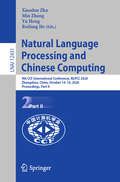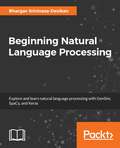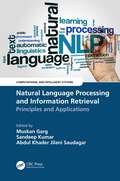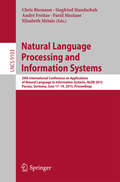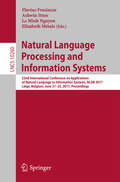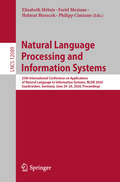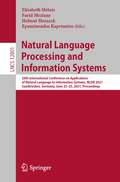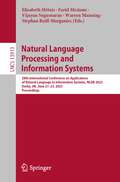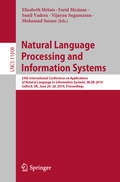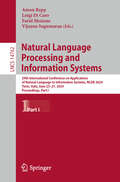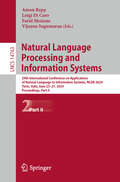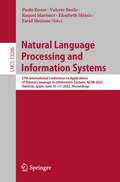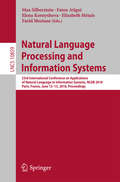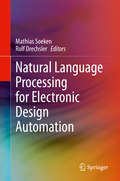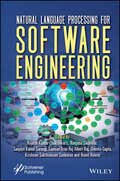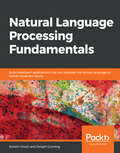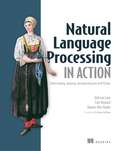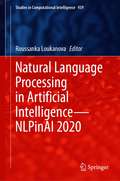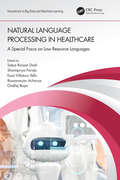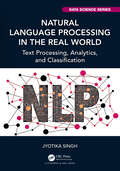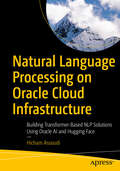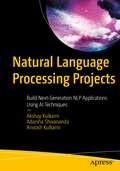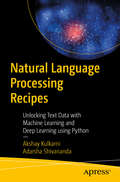- Table View
- List View
Natural Language Processing and Chinese Computing: 9th CCF International Conference, NLPCC 2020, Zhengzhou, China, October 14–18, 2020, Proceedings, Part II (Lecture Notes in Computer Science #12431)
by Xiaodan Zhu Min Zhang Yu Hong Ruifang HeThis two-volume set of LNAI 12340 and LNAI 12341 constitutes the refereed proceedings of the 9th CCF Conference on Natural Language Processing and Chinese Computing, NLPCC 2020, held in Zhengzhou, China, in October 2020.The 70 full papers, 30 poster papers and 14 workshop papers presented were carefully reviewed and selected from 320 submissions. They are organized in the following areas: Conversational Bot/QA; Fundamentals of NLP; Knowledge Base, Graphs and Semantic Web; Machine Learning for NLP; Machine Translation and Multilinguality; NLP Applications; Social Media and Network; Text Mining; and Trending Topics.
Natural Language Processing and Computational Linguistics: A practical guide to text analysis with Python, Gensim, spaCy, and Keras
by Bhargav Srinivasa-DesikanWork with Python and powerful open source tools such as Gensim and spaCy to perform modern text analysis, natural language processing, and computational linguistics algorithms.Key FeaturesDiscover the open source Python text analysis ecosystem, using spaCy, Gensim, scikit-learn, and KerasHands-on text analysis with Python, featuring natural language processing and computational linguistics algorithmsLearn deep learning techniques for text analysisBook DescriptionModern text analysis is now very accessible using Python and open source tools, so discover how you can now perform modern text analysis in this era of textual data.This book shows you how to use natural language processing, and computational linguistics algorithms, to make inferences and gain insights about data you have. These algorithms are based on statistical machine learning and artificial intelligence techniques. The tools to work with these algorithms are available to you right now - with Python, and tools like Gensim and spaCy.You'll start by learning about data cleaning, and then how to perform computational linguistics from first concepts. You're then ready to explore the more sophisticated areas of statistical NLP and deep learning using Python, with realistic language and text samples. You'll learn to tag, parse, and model text using the best tools. You'll gain hands-on knowledge of the best frameworks to use, and you'll know when to choose a tool like Gensim for topic models, and when to work with Keras for deep learning.This book balances theory and practical hands-on examples, so you can learn about and conduct your own natural language processing projects and computational linguistics. You'll discover the rich ecosystem of Python tools you have available to conduct NLP - and enter the interesting world of modern text analysis.What you will learn Why text analysis is important in our modern age Understand NLP terminology and get to know the Python tools and datasetsLearn how to pre-process and clean textual dataConvert textual data into vector space representationsUsing spaCy to process text Train your own NLP models for computational linguisticsUse statistical learning and Topic Modeling algorithms for text, using Gensim and scikit-learnEmploy deep learning techniques for text analysis using KerasWho this book is forThis book is for you if you want to dive in, hands-first, into the interesting world of text analysis and NLP, and you're ready to work with the rich Python ecosystem of tools and datasets waiting for you!
Natural Language Processing and Information Retrieval: Principles and Applications (Computational and Intelligent Systems)
by And Muskan Garg Sandeep Kumar Abdul Khader Jilani SaudagarThis book presents the basics and recent advancements in natural language processing and information retrieval in a single volume. It will serve as an ideal reference text for graduate students and academic researchers in interdisciplinary areas of electrical engineering, electronics engineering, computer engineering, and information technology. This text emphasizes the existing problem domains and possible new directions in natural language processing and information retrieval. It discusses the importance of information retrieval with the integration of machine learning, deep learning, and word embedding. This approach supports the quick evaluation of real-time data. It covers important topics including rumor detection techniques, sentiment analysis using graph-based techniques, social media data analysis, and language-independent text mining.Features:• Covers aspects of information retrieval in different areas including healthcare, data analysis, and machine translation• Discusses recent advancements in language- and domain-independent information extraction from textual and/or multimodal data• Explains models including decision making, random walk, knowledge graphs, word embedding, n-grams, and frequent pattern mining• Provides integrated approaches of machine learning, deep learning, and word embedding for natural language processing• Covers latest datasets for natural language processing and information retrieval for social media like Twitter The text is primarily written for graduate students and academic researchers in interdisciplinary areas of electrical engineering, electronics engineering, computer engineering, and information technology.
Natural Language Processing and Information Systems
by Chris Biemann Siegfried Handschuh André Freitas Farid Meziane Elisabeth MétaisThis book constitutes the refereed proceedings of the 20th International Conference on Applications of Natural Language to Information Systems, NLDB 2015, held in Passau, Germany, in June 2015. The 18 full papers, 15 short papers, 14 poster and demonstration papers presented were carefully reviewed and selected from 100 submissions. The papers cover the following topics: information extraction, distributional semantics, querying and question answering systems, context-aware NLP, cognitive and semantic computing, sentiment and opinion analysis, information extraction and social media, NLP and usability, text classification and extraction, and posters and demonstrations.
Natural Language Processing and Information Systems
by Flavius Frasincar Ashwin Ittoo Le Minh Nguyen Elisabeth MétaisThis book constitutes the refereed proceedings of the 17th International Conference on Applications of Natural Language to Information Systems, held in Groningen, The Netherlands, in June 2012. The 12 full papers, 24 short papers and 16 poster papers presented in this volume together with a full-paper length invited talks were carefully reviewed and selected from 90 submissions. The rapidly evolving state-of-the-art in NLP and the shifting interest to appcliations targeting document and data collections available on the Web, including an increasing amount of user generated content, is reflected in the contributions to this book. Topics covered are information retrieval, text classification and clustering, summarization, normalization of user generated content, "forensic" NLP, ontologies and natural language, sentiment analysis, question answering and information extraction, terminology and named entity recognition, and NLP tools development.
Natural Language Processing and Information Systems: 25th International Conference on Applications of Natural Language to Information Systems, NLDB 2020, Saarbrücken, Germany, June 24–26, 2020, Proceedings (Lecture Notes in Computer Science #12089)
by Elisabeth Métais Farid Meziane Helmut Horacek Philipp CimianoThis book constitutes the refereed proceedings of the 25th International Conference on Applications of Natural Language to Information Systems, NLDB 2020, held in Saarbrücken, Germany, in June 2020.* The 15 full papers and 10 short papers were carefully reviewed and selected from 68 submissions. The papers are organized in the following topical sections: semantic analysis; question answering and answer generation; classification; sentiment analysis; personality, affect and emotion; retrieval, conversational agents and multimodal analysis. *The conference was held virtually due to the COVID-19 pandemic.
Natural Language Processing and Information Systems: 26th International Conference on Applications of Natural Language to Information Systems, NLDB 2021, Saarbrücken, Germany, June 23–25, 2021, Proceedings (Lecture Notes in Computer Science #12801)
by Elisabeth Métais Farid Meziane Helmut Horacek Epaminondas KapetaniosThis book constitutes the refereed proceedings of the 26th International Conference on Applications of Natural Language to Information Systems, NLDB 2021, held online in July 2021. The 19 full papers and 14 short papers were carefully reviewed and selected from 82 submissions. The papers are organized in the following topical sections: role of learning; methodological approaches; semantic relations; classification; sentiment analysis; social media; linking documents; multimodality; applications.
Natural Language Processing and Information Systems
by Elisabeth Métais Farid Meziane Mohamad Saraee Vijayan Sugumaran Sunil VaderaThis book constitutes the refereed proceedings of the 21st International Conference on Applications of Natural Language to Information Systems, NLDB 2016, held in Salford, UK, in June 2016. The 17 full papers, 22 short papers, and 13 poster papers presented were carefully reviewed and selected from 83 submissions. The papers cover the following topics: theoretical aspects, algorithms, applications, architectures for applied and integrated NLP, resources for applied NLP, and other aspects of NLP.
Natural Language Processing and Information Systems: 28th International Conference on Applications of Natural Language to Information Systems, NLDB 2023, Derby, UK, June 21–23, 2023, Proceedings (Lecture Notes in Computer Science #13913)
by Elisabeth Métais Farid Meziane Vijayan Sugumaran Warren Manning Stephan Reiff-MarganiecThis book constitutes the refereed proceedings of the 28th International Conference on Applications of Natural Language to Information Systems, NLDB 2023, held in Derby, UK, in June 21–23, 2023The 31 full papers and 14 short papers included in this book were carefully reviewed and selected from 89 submissions. They focus on the developments of the application of natural language to databases and information systems in the wider meaning of the term.
Natural Language Processing and Information Systems: 24th International Conference on Applications of Natural Language to Information Systems, NLDB 2019, Salford, UK, June 26–28, 2019, Proceedings (Lecture Notes in Computer Science #11608)
by Elisabeth Métais Farid Meziane Sunil Vadera Vijayan Sugumaran Mohamad SaraeeThis book constitutes the refereed proceedings of the 24th International Conference on Applications of Natural Language to Information Systems, NLDB 2019, held in Salford, UK, in June 2019. The 21 full papers and 16 short papers were carefully reviewed and selected from 75 submissions. The papers are organized in the following topical sections: argumentation mining and applications; deep learning, neural languages and NLP; social media and web analytics; question answering; corpus analysis; semantic web, open linked data, and ontologies; natural language in conceptual modeling; natural language and ubiquitous computing; and big data and business intelligence.
Natural Language Processing and Information Systems: 29th International Conference on Applications of Natural Language to Information Systems, NLDB 2024, Turin, Italy, June 25–27, 2024, Proceedings, Part I (Lecture Notes in Computer Science #14762)
by Farid Meziane Vijayan Sugumaran Amon Rapp Luigi Di CaroThe two-volume proceedings set LNCS 14762 and 14763 constitutes the refereed proceedings of the 29th International Conference on Applications of Natural Language to Information Systems, NLDB 2024, held in Turin, Italy, in June 25–27, 2024. The 35 full papers, 26 short papers, 3 demo papers and 8 industry track papers included in these books were carefully reviewed and selected from 141 submissions. They focus on advancements and support studies related to languages previously underrepresented, such as Arabic, Romanian, Italian and Japanese languages.
Natural Language Processing and Information Systems: 29th International Conference on Applications of Natural Language to Information Systems, NLDB 2024, Turin, Italy, June 25–27, 2024, Proceedings, Part II (Lecture Notes in Computer Science #14763)
by Amon Rapp Luigi Di Caro Farid Meziane Vijayan SugumaranThe two-volume proceedings set LNCS 14762 and 14763 constitutes the refereed proceedings of the 29th International Conference on Applications of Natural Language to Information Systems, NLDB 2024, held in Turin, Italy, in June 25–27, 2024. The 35 full papers, 26 short papers, 3 demo papers and 8 industry track papers included in these books were carefully reviewed and selected from 141 submissions. They focus on advancements and support studies related to languages previously underrepresented, such as Arabic, Romanian, Italian and Japanese languages.
Natural Language Processing and Information Systems: 27th International Conference on Applications of Natural Language to Information Systems, NLDB 2022, Valencia, Spain, June 15–17, 2022, Proceedings (Lecture Notes in Computer Science #13286)
by Paolo Rosso Valerio Basile Raquel Martínez Elisabeth Métais Farid MezianeThis book constitutes the refereed proceedings of the 27th International Conference on Applications of Natural Language to Information Systems, NLDB 2022, held in Valencia, Spain in June 2022. The 28 full papers and 20 short papers were carefully reviewed and selected from 106 submissions. The papers are organized in the following topical sections: Sentiment Analysis and Social Media; Text Classification; Applications; Argumentation; Information Extraction and Linking; User Profiling; Semantics; Language Resources and Evaluation.
Natural Language Processing and Information Systems: 23rd International Conference on Applications of Natural Language to Information Systems, NLDB 2018, Paris, France, June 13-15, 2018, Proceedings (Lecture Notes in Computer Science #10859)
by Max Silberztein Faten Atigui Elena Kornyshova Elisabeth Métais Farid MezianeThis book constitutes the refereed proceedings of the 23rd International Conference on Applications of Natural Language to Information Systems, NLDB 2018, held in Paris, France, in June 2018. The 18 full papers, 26 short papers, and 9 poster papers presented were carefully reviewed and selected from 99 submissions. The papers are organized in the following topical sections: Opinion Mining and Sentiment Analysis in Social Media; Semantics-Based Models and Applications; Neural Networks Based Approaches; Ontology Engineering; NLP; Text Similarities and Plagiarism Detection; Text Classification; Information Mining; Recommendation Systems; Translation and Foreign Language Querying; Software Requirement and Checking.
Natural Language Processing for Electronic Design Automation
by Mathias Soeken Rolf DrechslerThis book describes approaches for integrating more automation to the early stages of EDA design flows. Readers will learn how natural language processing techniques can be utilized during early design stages, in order to automate the requirements engineering process and the translation of natural language specifications into formal descriptions. This book brings together leading experts to explain the state-of-the-art in natural language processing, enabling designers to integrate these techniques into algorithms, through existing frameworks.
Natural Language Processing for Software Engineering
by Rajesh Kumar Chakrawarti Ranjana Sikarwar Sanjaya Kumar Sarangi Samson Arun Raj Albert Raj Shweta Gupta Krishnan Sakthidasan Sankaran Romil RawatDiscover how Natural Language Processing for Software Engineering can transform your understanding of agile development, equipping you with essential tools and insights to enhance software quality and responsiveness in today’s rapidly changing technological landscape. Agile development enhances business responsiveness through continuous software delivery, emphasizing iterative methodologies that produce incremental, usable software. Working software is the main measure of progress, and ongoing customer collaboration is essential. Approaches like Scrum, eXtreme Programming (XP), and Crystal share these principles but differ in focus: Scrum reduces documentation, XP improves software quality and adaptability to changing requirements, and Crystal emphasizes people and interactions while retaining key artifacts. Modifying software systems designed with Object-Oriented Analysis and Design can be costly and time-consuming in rapidly changing environments requiring frequent updates. This book explores how natural language processing can enhance agile methodologies, particularly in requirements engineering. It introduces tools that help developers create, organize, and update documentation throughout the agile project process.
Natural Language Processing Fundamentals: Build intelligent applications that can interpret the human language to deliver impactful results
by Dwight Gunning Sy Hwang Dongjun JungNatural Language Processing Fundamentals is designed for novice and mid-level data scientists and machine learning developers, who want to gather and analyze text data to build an NLP-powered product. It'll help you to have prior experience of coding in Python - using data types, writing functions, and importing libraries. Some experience with linguistics and probability is useful but is not necessary.
Natural Language Processing in Action: Understanding, analyzing, and generating text with Python
by Hannes Hapke Cole Howard Hobson LaneSummaryNatural Language Processing in Action is your guide to creating machines that understand human language using the power of Python with its ecosystem of packages dedicated to NLP and AI.Purchase of the print book includes a free eBook in PDF, Kindle, and ePub formats from Manning Publications.About the TechnologyRecent advances in deep learning empower applications to understand text and speech with extreme accuracy. The result? Chatbots that can imitate real people, meaningful resume-to-job matches, superb predictive search, and automatically generated document summaries—all at a low cost. New techniques, along with accessible tools like Keras and TensorFlow, make professional-quality NLP easier than ever before.About the BookNatural Language Processing in Action is your guide to building machines that can read and interpret human language. In it, you'll use readily available Python packages to capture the meaning in text and react accordingly. The book expands traditional NLP approaches to include neural networks, modern deep learning algorithms, and generative techniques as you tackle real-world problems like extracting dates and names, composing text, and answering free-form questions.What's insideSome sentences in this book were written by NLP! Can you guess which ones?Working with Keras, TensorFlow, gensim, and scikit-learnRule-based and data-based NLPScalable pipelinesAbout the ReaderThis book requires a basic understanding of deep learning and intermediate Python skills.About the AuthorHobson Lane, Cole Howard, and Hannes Max Hapke are experienced NLP engineers who use these techniques in production.Table of ContentsPART 1 - WORDY MACHINESPackets of thought (NLP overview)Build your vocabulary (word tokenization)Math with words (TF-IDF vectors)Finding meaning in word counts (semantic analysis)PART 2 - DEEPER LEARNING (NEURAL NETWORKS)Baby steps with neural networks (perceptrons and backpropagation)Reasoning with word vectors (Word2vec)Getting words in order with convolutional neural networks (CNNs)Loopy (recurrent) neural networks (RNNs)Improving retention with long short-term memory networksSequence-to-sequence models and attentionPART 3 - GETTING REAL (REAL-WORLD NLP CHALLENGES)Information extraction (named entity extraction and question answering)Getting chatty (dialog engines)Scaling up (optimization, parallelization, and batch processing)
Natural Language Processing in Action, Second Edition (In Action)
by Hobson Lane Maria DyshelDevelop your NLP skills from scratch, with an open source toolbox of Python packages, Transformers, Hugging Face, vector databases, and your own Large Language Models.Natural Language Processing in Action, Second Edition has helped thousands of data scientists build machines that understand human language. In this new and revised edition, you&’ll discover state-of-the art Natural Language Processing (NLP) models like BERT and HuggingFace transformers, popular open-source frameworks for chatbots, and more. You&’ll create NLP tools that can detect fake news, filter spam, deliver exceptional search results and even build truthfulness and reasoning into Large Language Models (LLMs). In Natural Language Processing in Action, Second Edition you will learn how to: • Process, analyze, understand, and generate natural language text • Build production-quality NLP pipelines with spaCy • Build neural networks for NLP using Pytorch • BERT and GPT transformers for English composition, writing code, and even organizing your thoughts • Create chatbots and other conversational AI agents In this new and revised edition, you&’ll discover state-of-the art NLP models like BERT and HuggingFace transformers, popular open-source frameworks for chatbots, and more. Plus, you&’ll discover vital skills and techniques for optimizing LLMs including conversational design, and automating the &“trial and error&” of LLM interactions for effective and accurate results. About the technology From nearly human chatbots to ultra-personalized business reports to AI-generated email, news stories, and novels, natural language processing (NLP) has never been more powerful! Groundbreaking advances in deep learning have made high-quality open source models and powerful NLP tools like spaCy and PyTorch widely available and ready for production applications. This book is your entrance ticket—and backstage pass—into the next generation of natural language processing. About the book Natural Language Processing in Action, Second Edition introduces the foundational technologies and state-of-the-art tools you&’ll need to write and publish NLP applications. You learn how to create custom models for search, translation, writing assistants, and more, without relying on big commercial foundation models. This fully updated second edition includes coverage of BERT, Hugging Face transformers, fine-tuning large language models, and more. What's inside • NLP pipelines with spaCy • Neural networks with PyTorch • BERT and GPT transformers • Conversational design for chatbots About the reader For intermediate Python programmers familiar with deep learning basics. About the author Hobson Lane is a data scientist and machine learning engineer with over twenty years of experience building autonomous systems and NLP pipelines. Maria Dyshel is a social entrepreneur and artificial intelligence expert, and the CEO and cofounder of Tangible AI. Cole Howard and Hannes Max Hapke were co-authors of the first edition. Table fo Contents Part 1 1 Machines that read and write: A natural language processing overview 2 Tokens of thought: Natural language words 3 Math with words: Term frequency–inverse document frequency vectors 4 Finding meaning in word counts: Semantic analysis Part 2 5 Word brain: Neural networks 6 Reasoning with word embeddings 7 Finding kernels of knowledge in text with CNNs 8 Reduce, reuse, and recycle your words: RNNs and LSTMs Part 3 9 Stackable deep learning: Transformers 10 Large language models in the real world 11 Information extraction and knowledge graphs 12 Getting chatty with dialog engines A Your NLP tools B Playful Python and regular e
Natural Language Processing in Artificial Intelligence—NLPinAI 2020 (Studies in Computational Intelligence #939)
by Roussanka LoukanovaThis book covers theoretical work, applications, approaches, and techniques for computational models of information and its presentation by language (artificial, human, or natural in other ways). Computational and technological developments that incorporate natural language are proliferating. Adequate coverage encounters difficult problems related to ambiguities and dependency on context and agents (humans or computational systems). The goal is to promote computational systems of intelligent natural language processing and related models of computation, language, thought, mental states, reasoning, and other cognitive processes.
Natural Language Processing In Healthcare: A Special Focus on Low Resource Languages (Innovations in Big Data and Machine Learning)
by Satya Ranjan Dash Shantipriya Parida Esaú Villatoro Tello Biswaranjan Acharya Ondřej BojarNatural Language Processing In Healthcare: A Special Focus on Low Resource Languages covers the theoretical and practical aspects as well as ethical and social implications of NLP in healthcare. It showcases the latest research and developments contributing to the rising awareness and importance of maintaining linguistic diversity. The book goes on to present current advances and scenarios based on solutions in healthcare and low resource languages and identifies the major challenges and opportunities that will impact NLP in clinical practice and health studies.
Natural Language Processing in the Real World: Text Processing, Analytics, and Classification (Chapman & Hall/CRC Data Science Series)
by Jyotika SinghNatural Language Processing in the Real World is a practical guide for applying data science and machine learning to build Natural Language Processing (NLP) solutions. Where traditional, academic-taught NLP is often accompanied by a data source or dataset to aid solution building, this book is situated in the real world where there may not be an existing rich dataset. This book covers the basic concepts behind NLP and text processing and discusses the applications across 15 industry verticals. From data sources and extraction to transformation and modelling, and classic Machine Learning to Deep Learning and Transformers, several popular applications of NLP are discussed and implemented. This book provides a hands-on and holistic guide for anyone looking to build NLP solutions, from students of Computer Science to those involved in large-scale industrial projects.
Natural Language Processing on Oracle Cloud Infrastructure: Building Transformer-Based NLP Solutions Using Oracle AI and Hugging Face
by Hicham AssoudiThis book demonstrates how to use Oracle Cloud Infrastructure (OCI) and Hugging Face technologies to develop advanced NLP solutions. Through a practical case study, it addresses common NLP challenges and offers strategies for creating efficient, cost-effective transformer-based models. By the end of this book, you will have the skills and knowledge to create cutting-edge NLP solutions on OCI, customized to meet the needs of various industries and projects. The book takes you through the complete NLP solution life cycle—covering data preparation, model fine-tuning, deployment, and monitoring—while highlighting key topics such as cost-effectiveness and responsible AI for NLP implementations. Drawing from real-world experience and offering practical insights, it bridges the gap between theory and practice, equipping you to design and deploy scalable, cost-efficient NLP solutions. What You Will Learn Master key NLP concepts and the OCI ecosystem Create high-quality datasets using Hugging Face and OCI Data Labeling Service Fine-tune domain-specific pre-trained models from Hugging Face using OCI Data Science Notebook Sessions Deploy and operationalize your models with OCI Data Science Model Deployments Automate the NLP life cycle with OCI Data Science Pipelines Implement cost-effective strategies throughout the entire NLP life cycle, from dataset preparation to model training and deployment Who This Book Is For A diverse audience interested in implementing NLP solutions on Oracle Cloud Infrastructure: NLP practitioners, data scientists, and machine learning engineers who want to learn how to leverage Oracle AI and Hugging Face to implement an end-to-end NLP solution life cycle, from data preparation to model deployment; Oracle practitioners who want to expand their Oracle expertise by exploring OCI's advanced capabilities for building and scaling cutting-edge NLP solutions in enterprise environments; business decision makers who want to discover the strategic benefits of NLP solutions on OCI, including cost-effectiveness and responsible AI, while driving business value
Natural Language Processing Projects: Build Next-Generation NLP Applications Using AI Techniques
by Akshay Kulkarni Adarsha Shivananda Anoosh KulkarniLeverage machine learning and deep learning techniques to build fully-fledged natural language processing (NLP) projects. Projects throughout this book grow in complexity and showcase methodologies, optimizing tips, and tricks to solve various business problems. You will use modern Python libraries and algorithms to build end-to-end NLP projects. The book starts with an overview of natural language processing (NLP) and artificial intelligence to provide a quick refresher on algorithms. Next, it covers end-to-end NLP projects beginning with traditional algorithms and projects such as customer review sentiment and emotion detection, topic modeling, and document clustering. From there, it delves into e-commerce related projects such as product categorization using the description of the product, a search engine to retrieve the relevant content, and a content-based recommendation system to enhance user experience. Moving forward, it explains how to build systems to find similar sentences using contextual embedding, summarizing huge documents using recurrent neural networks (RNN), automatic word suggestion using long short-term memory networks (LSTM), and how to build a chatbot using transfer learning. It concludes with an exploration of next-generation AI and algorithms in the research space. By the end of this book, you will have the knowledge needed to solve various business problems using NLP techniques.What You Will LearnImplement full-fledged intelligent NLP applications with PythonTranslate real-world business problem on text data with NLP techniquesLeverage machine learning and deep learning techniques to perform smart language processingGain hands-on experience implementing end-to-end search engine information retrieval, text summarization, chatbots, text generation, document clustering and product classification, and more Who This Book Is ForData scientists, machine learning engineers, and deep learning professionals looking to build natural language applications using Python
Natural Language Processing Recipes: Unlocking Text Data with Machine Learning and Deep Learning using Python
by Akshay Kulkarni Adarsha ShivanandaImplement natural language processing applications with Python using a problem-solution approach. This book has numerous coding exercises that will help you to quickly deploy natural language processing techniques, such as text classification, parts of speech identification, topic modeling, text summarization, text generation, entity extraction, and sentiment analysis. Natural Language Processing Recipes starts by offering solutions for cleaning and preprocessing text data and ways to analyze it with advanced algorithms. You’ll see practical applications of the semantic as well as syntactic analysis of text, as well as complex natural language processing approaches that involve text normalization, advanced preprocessing, POS tagging, and sentiment analysis. You will also learn various applications of machine learning and deep learning in natural language processing.By using the recipes in this book, you will have a toolbox of solutions to apply to your own projects in the real world, making your development time quicker and more efficient. What You Will LearnApply NLP techniques using Python libraries such as NLTK, TextBlob, spaCy, Stanford CoreNLP, and many moreImplement the concepts of information retrieval, text summarization, sentiment analysis, and other advanced natural language processing techniques.Identify machine learning and deep learning techniques for natural language processing and natural language generation problemsWho This Book Is ForData scientists who want to refresh and learn various concepts of natural language processing through coding exercises.
